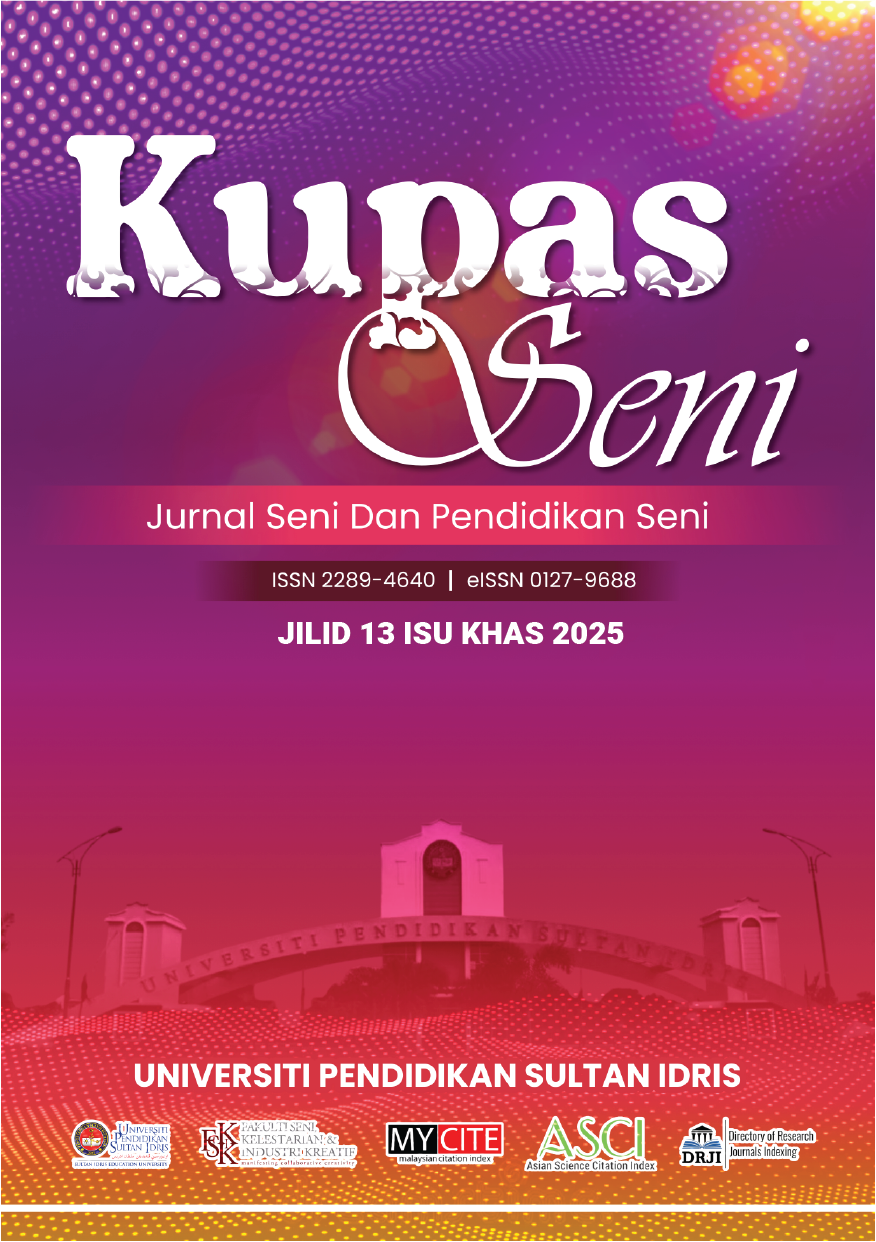The Role of Intermediaries in the Art World and their Impact on the Value of Artworks
DOI:
https://doi.org/10.37134/kupasseni.vol13.sp.8.2025Keywords:
Intermediaries, Art world, Art ValueAbstract
The purpose of this study is to analyze the impact of the role and function of intermediaries on the value of artworks. It describes and elaborates on the role of art intermediaries in the art world and how this value is interpreted by various stakeholders in the art community. This research employs a qualitative approach using a systematic literature review design, encompassing data collection, data analysis, coding, synthesis, and validity testing. The findings indicate that the role of intermediaries in the art ecosystem is crucial in dynamizing the social field of art. They serve as connectors between artists, artworks, and the public. Galleries, museums, curators, art critics, collectors, and art agents play diverse roles in shaping, promoting, and distributing artworks. Art intermediaries not only facilitate transactions but also help establish the reputations of artists and the credibility of their works. Their influence extends to shaping perceptions of the aesthetic, historical, and cultural value of artworks through organizing exhibitions, writing art criticism, and documenting art history. Additionally, intermediaries mediate dialogues between traditional and contemporary art practices, bridging gaps between creators and audiences. This dynamic role contributes significantly to the valuation process, which impacts not only economic aspects but also societal appreciation of art. By understanding these roles, stakeholders can better navigate the complexities of the art market and contribute to a more inclusive and vibrant art ecosystem.
Downloads
References
Antal, A. B. (2012). Artistic intervention residencies and their intermediaries: A comparative analysis. Organizational Aesthetics, 1(1), 44–67. https://oa.journals.publicknowledgeproject.org/index.php/oa/article/view/5
Barker, C. (2004). Cultural studies: Teori & praktik. Kreasi Wacana.
Bentcheva, E. (2022). Fluxus resonances in Southeast Asia. Southeast of Now: Directions in Contemporary and Modern Art in Asia, 6(1), 33–68. https://doi.org/10.1353/SEN.2022.0002
Braun, V., & Clarke, V. (2006). Using thematic analysis in psychology. Qualitative Research in Psychology, 3(2), 77–101. https://doi.org/10.1191/1478088706QP063OA
Campbell, M., Evans, C., & Wowk, L. (2022). Strategies for social engagement: Arts-service organizations as organizational intermediaries. Poetics, 92, 101652. https://doi.org/10.1016/J.POETIC.2022.101652
Creswell, J., & Poth, C. (2013). Qualitative inquiry and research design: Choosing among five approaches (3rd ed.). Sage Publications.
Damajanti, I., Sabana, S., & Adriati, I. (2014). Kajian aspek ketidaksadaran dalam karya seni rupa Indonesia periode 2000-2011. Journal of Urban Society’s Arts, 1(1), 17–26. https://doi.org/10.24821/JOUSA.V1I1.785
Dewi, C. S. (2021). Modul pelatihan berbasis kompetensi kurator seni rupa. Kementrian Pendidikan dan Kebudayaan. http://repository.ikj.ac.id/889/
Hastarika, G. (2021). Akses dalam praktik pemerantaraan kesenian di Indonesia - ProQuest. Antropologi Indonesia, 42(2), 125–138.
Heinich, N. (2012). Mapping intermediaries in contemporary art according to pragmatic sociology. European Journal of Cultural Studies, 15(6), 695–702. https://doi.org/10.1177/1367549412450634
Hujatnikajennong, A. (2015). Kurasi dan kuasa: Kekuratoran dalam medan seni rupa kontemporer di Indonesia. Marjin Kiri.
Ilyas, K. B., & Marcelleno, M. J. (2016). Arts marketing: Peran, interaksi, dan proses dalam medan seni rupa kontemporer di Jakarta (pendekatan kualitatif). Universitas Prasetiya Mulya.
Jesica, E. S., & Budiman, Ch. (2019). Ranah seni rupa Indonesia: Kolektor, pasar, dan penahbisan karya. Imajinasi: Jurnal Seni, 13(2), 75–88. https://doi.org/10.15294/IMAJINASI.V13I2.21945
Khairudin, K. A., Rashid, M. S. A., Gani, M. A. A. A., Yahaya, M. H., Zamari, Z. M., & Hamzah, A. F. A. (2022). Types and styles of painting preferred by a hotel in Malaysia. Malaysian Journal of Sustainable Environment, 9(2), 21–36. https://myjms.mohe.gov.my/index.php/myse/article/view/18826
Kotler, P., & Keller, K. L. (2016). Marketing management (15th ed.). Pearson.
Latifah, N. L., Anugrah, D. A., Aynani, M. D., & Garini, K. W. (2013). Kajian sistem pencahayaan yang mempengaruhi kenyamanan visual pada ruang A dan ruang sayap galeri Selasar Sunaryo. Reka Karsa: Jurnal Arsitektur, 1(3). https://doi.org/10.26760/REKAKARSA.V1I3.295
Muniz, A. M., & O’Guinn, T. C. (2001). Brand community. Journal of Consumer Research, 27(4), 412–432. https://doi.org/10.1086/319618
Nugroho, A. S. (2013). Desain sebagai “dagangan” simbolik. Deiksis, 5(01), 41–57. https://doi.org/10.30998/DEIKSIS.V5I01.460
Pakpahan, Y. E., Hasugian, C., Warat, M. D. I., Sari, Y. M., & Anugrah, J. (2023). Peningkatan motivasi kewirausahaan dan pengelolaan keuangan pada siswa SMA Negeri 1 Berastagi. INCOME: Indonesian Journal of Community Service and Engagement, 2(1), 44–48. https://doi.org/10.56855/INCOME.V2I1.226
Papaioannou, D., Sutton, A., & Booth, A. (2016). Systematic approaches to a successful literature review (2nd ed.). Sage Publications. https://www.torrossa.com/en/resources/an/5018623
Parta, I. W. S. (2009). Pengoleksian karya seni rupa sebagai gaya hidup. Jurnal Imaji Maranatha, 4(2), 176–189.
Potash, J. (2011). Art therapists as intermediaries for social change. Journal of Art for Life, 2(1). https://journals.flvc.org/jafl/article/view/84095
Saul, B. H. (1982). Art worlds. University of California Press.
Stevenson, M. (1993). The art market, its intermediaries and the components of value of art works in an historical perspective [University of Cape Town]. http://hdl.handle.net/11427/21499
Suminar, L. (2017). Galeri seni sebagai ruang publik dan pendukung identitas kota Yogyakarta. Academia.
Supangkat, J. (2017). Seni dan kurasi di perguruan tinggi seni. Jurnal Seni Nasional Cikini, 1(1), 73–81. https://doi.org/10.52969/JSNC.V1I1.49
Susanto, M. (2004). Menimbang ruang menata rupa. Galangpress Group.
Undiana, N. N. (2018). Seni dan media massa: Pengelolaan informasi seni rupa dalam media baru. ATRAT: Jurnal Seni Rupa, 6(2). https://doi.org/10.26742/ATRAT.V6I2.693
Wanlie, W. (2012). Produksi budaya dalam seni grafiti. Masyarakat: Jurnal Sosiologi, 17(2), 80–98. https://doi.org/10.7454/MJS.v17i2.1200
Yudistira, G. P., Endriawan, D., & Trihanondo, D. (2020). Analisis keberadaan pelukis Jelekong dalam medan sosial seni rupa di Bandung dan faktor penyebab eksistensinya dapat bertahan hingga sekarang. EProceedings of Art & Design, 7(2). https://openlibrarypublications.telkomuniversity.ac.id/index.php/artdesign/article/view/12508
Zulfikli, Z. (2021). Seni rupa di era disrupsi: Dampak teknologi dalam medan sosial seni rupa. Gondang, 5(1), 134–142. https://doi.org/10.24114/GONDANG.V5I1.24964
Downloads
Published
Issue
Section
License
Copyright (c) 2025 Galih Jatu Kurnia, Yukki Setiawan, Zakiah Pawitan

This work is licensed under a Creative Commons Attribution-NonCommercial-ShareAlike 4.0 International License.





